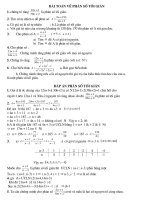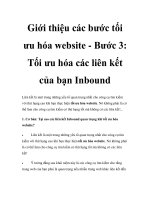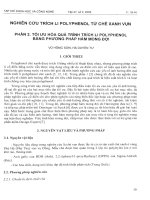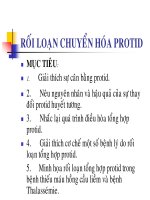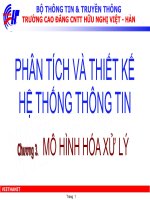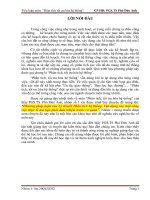Bài giảng Phần 3: Tối ưu hóa
Bạn đang xem bản rút gọn của tài liệu. Xem và tải ngay bản đầy đủ của tài liệu tại đây (363.72 KB, 23 trang )
Phần 3: Tối ưu hóa
Modeling, simulation and optimization for chemical process
Instructor: Hoang Ngoc Ha
Email:
Bộ môn QT&TB
T. F. Edgar, D. M. Himmelblau. Optimization of chemical Processes.
Second edition.
Bùi Minh Trí. Tối ưu hóa (lý thuyết và bài tập). NXB KHKT, Hà Nội, 2005.
CuuDuongThanCong.com
/>
Introduction
The chemical industry has undergone
significant changes during the past 25 years
due to the
increased cost of energy
increasingly stringent environmental regulations
global competition in product pricing and quality
…
One of the most important engineering tools for
addressing these issues is optimization
Decision-making process
CuuDuongThanCong.com
/>
Introduction
As the power of computers has increased,
the size and complexity of problems that can
be solved by optimization techniques have
correspondingly expanded
The necessary tools for solving problem
We will focus on those techniques and discuss
software that offers the most potential for
success and gives reliable results
CuuDuongThanCong.com
/>
Outline
Problem formulation
Optimization theory and methods
Optimization of unconstrained functions
Linear programming with constraints
Nonlinear programming with constraints
Multi-objective optimization
Nature and organization of Optimization problems
Developing models for optimization (constraints or
process model)
Formulation of the objective function
Applications of Optimization
CuuDuongThanCong.com
/>
Optimization
OPTIMIZATION IS THE use of specific methods to
determine the most cost-effective and efficient
solution to a problem or design for a process
This technique is one of the major quantitative tools
in industrial decision making
A wide variety of problems in the design,
construction, operation, and analysis of chemical
plants (as well as many other industrial processes)
can be resolved by optimization
CuuDuongThanCong.com
/>
Problem formulation
Formulating the problem is perhaps the most crucial
step in optimization (from verbal statement of a
given application and organizing them into a
prescribed mathematical form)
The objective function (economic criterion)
The process model (constraints)
The objective function represents such factors as
profit, cost, energy, and yield in terms of the key
variables of the process being analyzed
The process model and constraints describe the
interrelationships of the key variables
CuuDuongThanCong.com
/>
Problem formulation
What optimization is all about
Optimization is concerned with selecting the best
value by efficient quantitative methods
Why optimize?
Largest production
Greatest profit
Minimum cost
The least energy usage
…
CuuDuongThanCong.com
/>
Problem formulation
Examples of applications of optimization
Determining the best sites for plant location
Routing tankers for the distribution of crude and refined products
Sizing and layout of a pipeline
Designing equipment and an entire plant
Scheduling maintenance and equipment replacement
Operating equipment, such as tubular reactors, columns, and
absorbers
Evaluating plant data to construct a model of a process
Minimizing inventory charges
Allocating resources or services among several processes
Planning and scheduling construction
…
Example: See ref.
CuuDuongThanCong.com
/>
Problem formulation
Main features of optimization problems
At least one objective function to be optimized
Equality constraints (equations)
Inequality constraints (inequalities)
}
Model of process
or equipment
Economic model
CuuDuongThanCong.com
/>
Problem formulation
Main features of optimization problems
Feasible solution/Feasible region
Optimal solution
Degrees of freedom
Underdetermined
Overdetermined
CuuDuongThanCong.com
/>
Problem formulation
An optimization problem:
Minimize: f (x) objective function
Subject to: h(x) = 0 equality constraints
g(x) ≥ 0 inequality constraints
where x = (x1 · · · xn ) ∈ X ⊂ Rn
h(x) is a vector of equations of dim. m1
g(x) is anvector of equations of dim.
o m2
D = x ∈ X|h(x) = 0, g(x) ≥ 0
CuuDuongThanCong.com
/>
Problem formulation
Example: optimal scheduling
tA1
tB1
CuuDuongThanCong.com
tA 2
tB2
/>
Problem formulation
What is the objective function?
f (t) = tA1 MA1 SA1 + tA2 MA2 SA2
+tB1 MB1 SB1 + tB2 MB2 SB2
tA1 + tA2 = 365
tAi ≥ 0
tB1 + tB2 = 365
tBi ≥ 0
CuuDuongThanCong.com
/>
Problem formulation
Các loại bài toán tối ưu (quy hoạch toán học)
Quy hoạch tuyến tính (QHTT)
f (x), g(x), h(x) là tuyến tính
Ví dụ thuộc dạng này có Bài Toán Vận Tải
Quy hoạch tham số (QHTS) là QHTT mà các hệ số trong
f (x), g(x), h(x) phụ thuộc tham số
Quy hoạch động (QHĐ):
Là quá trình có nhiều giai đoạn nói chung, hay các quá trình
phát triển theo thời gian nói riêng
CuuDuongThanCong.com
/>
Problem formulation
Các loại bài toán tối ưu (quy hoạch toán học)
Quy hoạch phi tuyến (QHPT)
f (x) hoặc g(x) hoặc h(x) là các hàm phi tuyến
Quy hoạch rời rạc (QHRR)
Nếu miền ràng buộc D là tập rời rạc
Quy hoạch đa mục tiêu (QHĐMT)
Nếu trên cùng một miền ràng buộc D ta xét nhiều hàm
mục tiêu khác nhau
CuuDuongThanCong.com
/>
Formulation of the objective function
Translate a verbal statement or concept of
the desired objective into mathematical terms
Example
CuuDuongThanCong.com
/>
Formulation of the objective function
Example
CuuDuongThanCong.com
/>
Formulation of the objective function
Example
CuuDuongThanCong.com
/>
Formulation of the objective function
Example
CuuDuongThanCong.com
/>
Problem formulation
The six steps used to solve optimization
problems
Make a list of all of the process variables
Determine the criterion for optimization, and
specify the objective function in terms of the
variables defined in step 1 together with
coefficients (Economic model)
Using mathematical expressions, develop a valid
process or equipment model (Process model)
that relates the input-output variables of the
process and associated coefficients
Problem formulation
CuuDuongThanCong.com
/>
Problem formulation
The six steps used to solve optimization
problems
If the problem formulation is too large in scope
Break it up into manageable parts or
Simplify the objective function and model
Apply a suitable optimization technique to the
mathematical statement of the problem
Check the answers, and examine the sensitivity of
the result to changes in the coefficients in the
problem and the assumptions
CuuDuongThanCong.com
/>
Outline
Problem formulation
Optimization theory and methods
Optimization of unconstrained functions
Linear programming with constraints
Nonlinear programming with constraints
Multi-objective optimization
Nature and organization of Optimization problems
Developing models for optimization (constraints or
process model)
Formulation of the objective function
Applications of Optimization
CuuDuongThanCong.com
/>
Scope of course
OPTIMIZATION OF UNCONSTRAINED
FUNCTIONS: ONE-DIMENSIONAL SEARCH
UNCONSTRAINED
MULTIVARIABLE OPTIMIZATION
Optimization problems
LINEAR PROGRAMMING
NON LINEAR PROGRAMMING
MULTI-OBJECTIVE OPTIMIZATION
(OR MULTI-OBJECTIVE PROGRAMMING)
CuuDuongThanCong.com
/>
